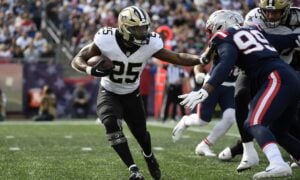Doing it Again: Seasonal Scoring in Linebackers
In the off-season we’re consumed by attempting to predict the coming year. Naturally, the biggest single predictor of future performance is recent-past performance. In this series so far, we’ve looked at defensive line and safeties. Today we focus on the glamour position of linebacker.
The point of this article is to understand how repeatable LB success is and has been, and therefore what reasonable level of confidence we can have in last year’s top LBs being as good this year. This is not (at this stage) about identifying which of last year’s top LBs might not repeat – just working out what number we can expect to not be at the top of the 2019 list.
The table below lists the last 10 seasons of top-24 LBs (applying the same fairly standard scoring system to all years equally). For the sake of completeness, it’s worth noting that return yardage and defensive TDs are not included here. They’re so unpredictable it just skews the data.
Players with a green box next to their name are repeat performers. That is, they finished in the top 24 two years in a row. Some players managed numerous consecutive seasons (Paul Posluszny was a beast), but for the sake of this exercise all we care about is “can they repeat?”

The number in the black boxes at the bottom is the number of repeatees per year. You can see it varies from just nine in 2014 and 2018, all the way up to 15 in 2017. The average has been just under 12. So, we can expect roughly 50% of last year’s top 24 LBs to be there again in 2019.
As a reminder the figure for the other positions was:
DT 44%
DE 44%
S 40%
LB at 48% is slightly ahead but not notably so.
Let’s dive in a bit closer and look at LB1s – the top 12.

You can instantly see there are fewer green boxes here. It’s varied from two to five over this period and averaged out at just under four. If we want to be pedantic about it then just 30.6% of LB1s repeat the year after. It was five a year ago. It’s natural that our belief that LBs repeat is even stronger than normal, but most of 2018s top-12 LBs will not be in that range after 2019. Whichever LB who had a great 2018 you have on your roster, chances are he isn’t going to be as good in 2019.
That’s a pretty depressing way to think about it, but it makes sense when you delve into it. There are a lot of LBs who are heavily involved week-to-week. Only the very best (by definition) are elite IDP options. The top 12 are players who managed to stay healthy and for whom everything worked out beautifully across the season. Just looking at some of the names here you can see that’s true.
Darius Leonard, Leighton Vander Esch, Tremaine Edmunds and Roquan Smith had extraordinarily efficient rookie seasons. Cory Littleton came out of nowhere as the Rams significantly changed their scheme last year. Mason Foster, Kiko Alonso and Tahir Whitehead all played fairly average but stayed healthy in great spots.
Some of these players will probably get lucky again but it’s very easy to see how any of them could fall way out of the top 12 with just a slight change in fortunes. It’s fine to roster these guys, but make sure you’re looking at them realistically rather than through rose-tinted glasses. The data above absolutely shows that we cannot trust LBs to keep producing year-after-year.
That’s fairly meaningless without some data behind it though, so (in no particular order) I list below the main reasons for players to fall out of the top tier.
Injury
Injury is not a freak occurrence in the NFL for defensive players. It’s a very common issue. In week one of 2018 43 inside LBs played 50 or more snaps (which you need to average to hit 800 for the season – a reasonable entry amount for a top IDP LB). Of those 43 players, 16 failed to hit 800 snaps, while 29 missed at least a game and 21 missed at least two games.
To be a top-24 LB you’re looking for at least 850 snaps. To be top-12 LB, 950 snaps is the benchmark. Missing just a game or two is a real problem. It doesn’t make it impossible, but it does make it unlikely.
Team volume
Some teams play more than others on defense. As casual fans, we assume this evens out over time and is fairly close but it’s really not. In 2018 the average defensive full-time starter on the Browns and Chiefs were playing about 12 snaps more per game than full-time players on the Lions, Panthers and Seahawks.
Over a full season that’s an extra 192 snaps – about three extra games! Again, that’s a really difficult barrier to overcome for players. Not impossible (Bobby Wagner was more productive than Anthony Hitchens), but it’s very hard to produce on fewer snaps and team snaps can change very quickly. The Chiefs picked up all that volume last year because of game script. The Browns happened to play four overtime games. Neither of those was very predictable.
Change of scheme
With different coaches, teams use certain players more or less. This includes offensive coaches, too, as there is a relationship between the two sides of the ball. Add player movement into this and you can see why LBs can often produce much less year-over-year.
Plenty of fans think Kiko Alonso is a good NFL player because he racks up tackles. He’s a poor player and with a new defensive-minded head coach on board his days could be numbered.
Replacement
Players get replaced. Players we think are good are often replaced or phased out leaving fans standing around looking confused. Players age faster than we think they do.
Bobby Wagner is still a star player, but the Seahawks know his contract is up after 2019 and drafted two inside LBs. This sort of thing happens all the time.
Luck
There are a lot of variables in defensive football. It’s a reactive not proactive thing to predict, so it’s vulnerable to outside influence (i.e., opposing play calling).
Cory Littleton was the beneficiary last year of the Rams having a great offense but also the fact that Wade Phillips shuffled his personnel. 2018 was bizarre for the Rams from a production PoV (for Littleton and John Johnson at least) and that could easily revert back in 2019.
So there are a few reasons why players in last year’s top 12 might regress a bit. It’s still more likely for the guys who have already done it to do it again than it is for a lower-down player, but please don’t count on the same thing happening again. As we saw earlier the chance of that top-12 LB on your roster repeating his excellent performance is just 30.6%. Those are poor odds.
Thanks for reading. Comments appreciated!
- Ten IDP Fantasy Football Stats You Need to Know after Week 16 - December 29, 2023
- Ten IDP Fantasy Football Stats You Need to Know after Week 15 - December 22, 2023
- Ten IDP Fantasy Football Stats You Need to Know after Week 14 - December 14, 2023


































































